QARANC History
The history of the British Army Nurses from The Queen Alexandra's Imperial Nursing service through to the modern Queen Alexandra's Royal Army Nursing Corps (QARANC)
Crimea War Nurses
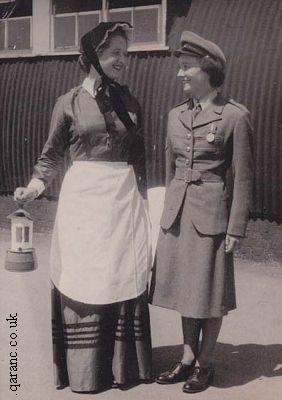 The History of the modern day QARANC (Queen Alexandra's Royal Army Nursing Corps) can be traced back to the Crimea
War. Florence Nightingale took 38 women to work as nurses and nursing attendants at Scutari Hospital from 1854 to 1856. She was recruited
by the Secretary of State for War, Sidney Herbert, to lead the women in tending the wounds of the injured soldiers. He had identified
the need for a nursing service because soldiers had little medical care and treatment and were dying from neglect as
well as their horrific wounds. Florence Nightingale's title was Superintendent of the Female Nursing Establishment of the English General Hospitals in Turkey.
The History of the modern day QARANC (Queen Alexandra's Royal Army Nursing Corps) can be traced back to the Crimea
War. Florence Nightingale took 38 women to work as nurses and nursing attendants at Scutari Hospital from 1854 to 1856. She was recruited
by the Secretary of State for War, Sidney Herbert, to lead the women in tending the wounds of the injured soldiers. He had identified
the need for a nursing service because soldiers had little medical care and treatment and were dying from neglect as
well as their horrific wounds. Florence Nightingale's title was Superintendent of the Female Nursing Establishment of the English General Hospitals in Turkey. Grey and Scarlet: letters from the war areas by army sisters on active service
The second UK military hospital The Royal Herbert was named after Sidney Herbert.
Florence Nightingale and her nurses revolutionised the care of sick and wounded officers and men of the British Army, preventing many deaths and enabling many to return to active duty.
After she left the Crimea Florence Nightingale was retained by the War Office as the General Superintendent of the Female Nursing Establishment of the Military Hospitals of the Army. In 1860 Florence Nightingale then established the Nightingale Training School for Probationer Nurses at St Thomas's Hospital, London. Several years later she wrote the handbook The Introduction of Female Nursing into Military Hospitals. She was retained by the War Office as a consultant on army welfare until 1872.
Follow us on Facebook, Instagram and Twitter.

My PTSD assistance dog, Lynne, and I have written a book about how she helps me with my military Post Traumatic Stress Disorder, anxiety, and depression. I talk about my time in the QAs and the coping strategies I now use to be in my best health.
Along the way, I have had help from various military charities, such as Help for Heroes and The Not Forgotten Association and royalties from this book will go to them and other charities like Bravehound, who paired me with my four-legged best friend.
I talk openly about the death of my son by suicide and the help I got from psychotherapy and counselling and grief charities like The Compassionate Friends.
The author, Damien Lewis, said of Lynne:
"A powerful account of what one dog means to one man on his road to recovery. Both heart-warming and life-affirming. Bravo Chris and Lynne. Bravo Bravehound."
Download.
Buy the Paperback.

This beautiful QARANC Poppy Pin Badge is available from the Royal British Legion Poppy Shop.
For those searching military records, for information on a former nurse of the QAIMNS, QARANC, Royal Red Cross, VAD and other nursing organisations or other military Corps and Regiments, please try Genes Reunited where you can search for ancestors from military records, census, birth, marriages and death certificates as well as over 673 million family trees. At GenesReunited it is free to build your family tree online and is one of the quickest and easiest ways to discover your family history and accessing army service records.
More Information.
Another genealogy website which gives you access to military records and allows you to build a family tree is Find My Past which has a free trial.
Military General Hospitals
Queen Victoria soon learnt about her work and in 1860 ordered a hospital be built to train Army nurses and surgeons be built. This was the Royal Victoria Hospital at Netley. The hospital opened in 1863 and soon admitted and cared for military patients. From 1866 nurses were formally appointed to Military General Hospitals. The nursing personnel came under the direction of The Army Nursing Service (ANS) from 1881.
Grey and Scarlet: letters from the war areas by army sisters on active service
Boer and Egyptian Wars
Members of the new Army Nursing Service were sent to the First Boer War (often called Zulu War) from 1879 to 1881, later to the Egyptian Campaign in 1882 and the Sudan War of 1883 to 1884. During the Sudan War members of the Army Nursing Service nursed in hospital ships on the Nile as well as the Citadel in Cairo. It is thought that the first white women to go up the Nile were army nurses (cited in the book Queen Alexandra's Royal Army Nursing Corps (Famous Regts. S)
See the Cabinet Card page for an example of a photo from this era.
During the second Boer War, the Anglo-Boer War of 1899 to 1902 the Army Nursing Service was mobilised to tend the wounded in tented field hospitals in areas like Chiveley, Frere, Natal, Pietermaritzburg and Wynburg. As this second Zulu War progressed local buildings were commandeered and converted into hospitals such as No 3 general Hospital at Kroonstad. Sisters of the Army Nursing Service also nursed aboard troop ambulance trains and hospital ships.
Conditions were harsh for the nurses and 23 Army Nursing Sisters died from diseases despite their hard work at maintaining hygiene and order. Women in the War Zone: Hospital Service in the First World War
 Nursing Sisters also served in Malta and Gibraltar in the newly opened military hospitals. At home nurses served at the
Cambridge Military Hospital in Aldershot, at the Brigade of Guards Hospital, London and within two
years at each military hospital which had over 100 beds. Army Nurses also served at military hospitals in Shorncliffe, Canterbury, Devonport, Dover, Portsmouth and Gosport.
Nursing Sisters also served in Malta and Gibraltar in the newly opened military hospitals. At home nurses served at the
Cambridge Military Hospital in Aldershot, at the Brigade of Guards Hospital, London and within two
years at each military hospital which had over 100 beds. Army Nurses also served at military hospitals in Shorncliffe, Canterbury, Devonport, Dover, Portsmouth and Gosport.

Former Royal Air Force Regiment Gunner Jason Harper witnesses a foreign jet fly over his Aberdeenshire home. It is spilling a strange yellow smoke. Minutes later, his wife, Pippa, telephones him, shouting that she needs him. They then get cut off. He sets straight out, unprepared for the nightmare that unfolds during his journey. Everyone seems to want to kill him.
Along the way, he pairs up with fellow survivor Imogen. But she enjoys killing the living dead far too much. Will she kill Jason in her blood thirst? Or will she hinder his journey through this zombie filled dystopian landscape to find his pregnant wife?
The Fence is the first in this series of post-apocalyptic military survival thrillers from the torturous mind of former British army nurse, now horror and science fiction novel writer, C.G. Buswell.
Download Now.
Buy the Paperback.
If you would like to contribute to this page, suggest changes or inclusions to this website or would like to send me a photograph then please e-mail me.
Princess Christian's Army Nursing Reserve
This section has moved to the Princess Christian's Army Nursing Reserve PCANR page.
Royal Red Cross Medal
Twenty years later since the building of Netley hospital Queen Victoria was still taking an interest in army nursing and nurses. She created a decoration to honour and reward their skills, dedication, bravery and exceptional services in military nursing. It was called the Royal Red Cross (RRC) and at the time was the first British military order just for women, until 1976. It is now awarded to men as well since they now form part of the QARANC rather then the Royal Army Medical Corps. There are no rank exemptions to being awarded the RRC or its other award the Associate Royal Red Cross Medal (ARRC).
The Queen Alexandra's Imperial Military Nursing Service
 The War Office took a more active interest in army nurses because of how quickly and efficiently they were treating soldiers in the Second Boer War. These soldiers
were returned to active duty quicker and the War Office saw the potential savings in manpower and costs.
The War Office took a more active interest in army nurses because of how quickly and efficiently they were treating soldiers in the Second Boer War. These soldiers
were returned to active duty quicker and the War Office saw the potential savings in manpower and costs.
On the 23 June 1898 the Royal Army Medical Corps was formed by Royal Warrant. The Director General of the Army Medical Services was Alfred Keogh (Keogh Barracks in Ashvale was named in his honour and is the HQ of the RAMC). In 1901 he placed army nursing sisters of the Army Nursing Services onto the war establishment of the Medical Services. The War Office officially formed The Queen Alexandra's Imperial Military Nursing Service (QAIMNS) on the 27 March 1902 under a Royal Warrant to replace the Army Nursing Service and the Indian Nursing Service. There were 39 nurses, 9 nursing sisters and four Superintendents in India at the time of the 22 July 1901 Report of the Royal Commission on the Care and Treatment of the Sick and Wounded during the South African Campaign cited in the book Queen Alexandra's Royal Army Nursing Corps (Famous Regts. S)
Amongst the recommendations the Committee suggested that good nurses could be found amongst the wives of officers, the introduction of a Principal matron, the duties of the Matron in Chief and the recommendation that Queen Alexandria be asked to become the president of the new service which would then be called The Queen Alexandra's Imperial Military Nursing Service .
Members of the Committee included Surgeon General Hooper, the Secretary of State for War William St John Brodrick, the surgeon Sir Frederick Treves
So the QAIMNS was formed from the Army Nursing Service whilst the Queen Alexandra's Imperial Military Nursing Service QAIMNS (I) was formed from the Indian Nursing Service.
The Royal Warrant was signed by King Edward VII and countersigned by William St John Brodrick the Secretary of State for War. In the book Queen Alexandra's Royal Army Nursing Corps (Famous Regts. S)
Whereas We deem it expedient to further provide for the nursing services of Our Army: Our Will and Pleasure is that an Imperial Military Nursing Services, to be designated the Queen Alexandra's Imperial Military Nursing Service and comprising Our Army Nursing Service, shall be established and the regulations contained in the Warrant of Our late Royal Mother, dated 26 October, 1900, shall be amended as follows...
The first President of the QAIMNS was Queen Alexandra who chose the motto and insignia of the service.
The insignia was a white cross taken from the Danish flag from where she came from the Order of Dannebrog. The motto was Sub-Crucia Candida which meant Under the White Cross. Queen Alexandra remained the President until her death in 1925. Queen Mary then became the President.
The QAIMNS expanded over the years and recruited many more nurses, so much so that in the First World War there were over 100,000 nurses in active service. These nurses served in countries such as East Africa, Egypt, France, India, Italy, Mesopotamia, Palestine, Salonika and Russia.
Read more about the QAIMNS and WWI in the QAIMNS First World War page.
Territorial Force Nursing Service
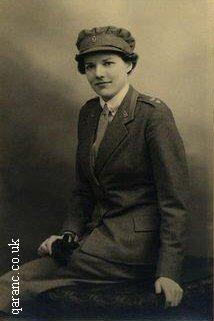 The QAIMNS Reserve and the
Territorial Force Nursing Service (1907) was formed and they too served during the First
World War with the Expeditionary Force.
The QAIMNS Reserve and the
Territorial Force Nursing Service (1907) was formed and they too served during the First
World War with the Expeditionary Force.
In 1908 there were 3000 members of the Territorial Force Nursing Service (TFNS) and their role was to serve around Great Britain in the 23 Territorial Hospitals (TH) which were controlled by the War Office and under Army administration (cited in It's a Long Way to Tipperary: British and Irish Nurses in the Great War
In 1921 the Territorial Force was renamed to the Territorial Army (TA) and so the Territorial Force Nursing Service (TFNS) became the Territorial Army Nursing Service (TANS)
See also Photo of Greatcoat TFNS.
Voluntary Aid Detachment
The Voluntary Aid Detachment was formed in August 1909 with the function of providing nursing and medical assistance during a time of war. VADs would work as nursing assistants, ambulance drivers, letter writers for wounded soldiers and cooks in France, Belgium, Gallipoli, Mesopotamia and the UK in field hospitals, base hospitals, convalescent hospitals and in the wards of Military Hospitals. The VAD were under the control of the British Red Cross Society which had previously been known as the British National Aid Society. The Voluntary Aid Detachment were trained in first aid and nursing duties like bed bathing, hygiene and sanitation. There is more written about the Voluntary Aid Detachment on the QAIMNS page and on the Voluntary Aid Detachment page.
It's a Long Way to Tipperary: British and Irish Nurses in the Great War
Queen Alexandra's Military Families Nursing Service
The Queen Alexandra's Military Families Nursing Service (QAMFNS) was established in 1921 (cited in the book Queen Alexandra's Royal Army Nursing Corps (Famous Regts. S)
Read the list of members on the QAMFNS Queen Alexandra's Military Families Nursing Service page.

In 1926 QAIMNS nursing sisters were granted regular army officer rank though not an army commission or rank structure until 1941.
Quetta Earthquake
On the 31 May 1935 QAs were mobilised to Quetta in North West India to care for the thousands of injured people from an earthquake. A tented field hospital was set up and operations were performed and the injured nursed until they could be evacuated to local hospitals such as the Mayo hospital in Lahore. This was the first time members of the QAIMNS were involved with the air evacuation of casualties and indeed the first time in history that QAs were flown into an area to administer nursing care.
The book Queen Alexandra's Royal Army Nursing Corps (Famous Regts. S)
Second World War
During the Second World War The Queen Alexandra's Imperial Military Nursing Service continued to look after the medical and nursing care of soldiers.
 In 1941 nursing sisters were awarded badges of rank from Lieutenant through to Brigadier when an emergency commission was granted. Previously
they all had officer status though had no distinction of rank and were not permitted to wear badges of rank. This was approved by Queen Mary on the 15 March and given
approval by King George VI on the 30 April 1941 (cited in the book Queen Alexandra's Royal Army Nursing Corps (Famous Regts. S)
In 1941 nursing sisters were awarded badges of rank from Lieutenant through to Brigadier when an emergency commission was granted. Previously
they all had officer status though had no distinction of rank and were not permitted to wear badges of rank. This was approved by Queen Mary on the 15 March and given
approval by King George VI on the 30 April 1941 (cited in the book Queen Alexandra's Royal Army Nursing Corps (Famous Regts. S)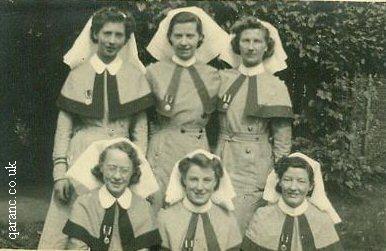
The Queen Alexandra's Royal Army Nursing Corps
On the 1 February 1949 the QAIMNS became a corps and were renamed The Queen Alexandra's Royal Army Nursing Corps because of the Women's Forces of the Crown Act (Army Order 5/1949).
The book Queen Alexandra's Royal Army Nursing Corps (Famous Regts. S)
A copy of the Royal Warrant can be seen on the QA Corps Warrant page.

Initially the Corps only had nursing officers in the regular service with supplementary staff from the Territorial Army (TA) and the Regular Army Reservists. The next year, in 1950, student nursing began. This saw the introduction of Other Ranks (OR's) servicewomen, on 1st July (A.C.I. 455/1950). The members of the Territorial Army Nursing Service (TANS) were integrated into the Queen Alexandra's Royal Army Nursing Corps and the TANS were disbanded. Other changes included renaming The Matrons-in-Chiefs to Director Army Nursing Services.
New Zealand Army Nursing Service Alliances
Royal Australian Army Nursing Corps Alliance
The following three photographs come from the collection of Sergeant Jean Miller whose photo is also at the top of this history page. Below each picture is the text she has written on the back:
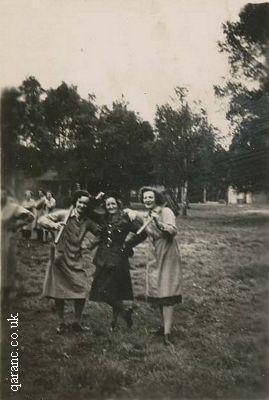
Where's that blinkin' bucket? What a unit! Jean, Oct '50. Jean Miller is on the left with Kathy Gibley on the right.
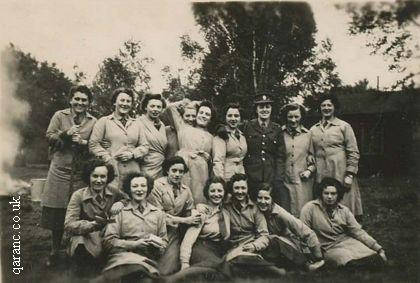
That's toilet paper we got there. The months supply. Jean, Oct '50. Jean Miller front left, with arm on Kathy's shoulder.
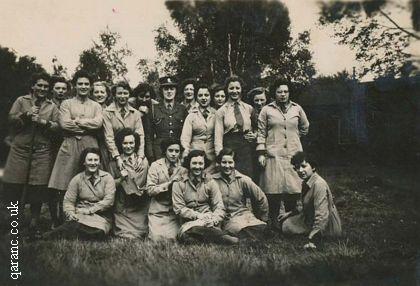
Me and the gals take a few minutes rest in the middle of cleaning. Jean, Oct '50 Jean front, second from left, Kathy's hands on her shoulders.
It is thought that these photos were taken during induction training.
One year after the QARANC were formed members were mobilised to care for the injured and wounded troops of the United Nations that were protecting South Korea from a Communist invasion known as the Korean War. QAs served in field hospitals, at Commonwealth Hospitals and aboard hospital ships. Read more about the Korean War and the QARANC.
Queen's Coronation Parade
Members of the QAs took part in the Queen's Coronation Parade in 1953, led by Sister Margot Turner. An account is written about this event in the history of the QARANC in Surviving Tenko: The Story of Margot Turner
Colonel-in-Chief of QARANC
Queen Mary remained the President of the newly formed QA's. The role was now named Colonel-in-Chief of QARANC. She remained the Colonel-in-Chief until her death in 1953. She was succeeded by Her Royal Highness Princess Margaret until her death in 2002. From July 2003 the third Colonel-in-Chief is Her Royal Highness The Countess of Wessex. HRH The Countess of Wessex is also the Patron of the Queen Alexandra's Royal Army Nursing Corps Association.
In October 1967 the QA Training Centre in Aldershot was officially opened. This replaced the Queen Alexandra Barracks which had been used as the QARANC Depot.
Male Nurses
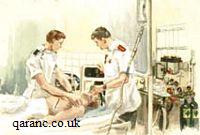 Male student nurses and trained nurses were soon introduced to the British Army to expand their status from medical
orderlies or medics. They remained under the remit of the Royal Army Medical Corps (RAMC) until 1992 when they
rebadged to QARANC.
Male student nurses and trained nurses were soon introduced to the British Army to expand their status from medical
orderlies or medics. They remained under the remit of the Royal Army Medical Corps (RAMC) until 1992 when they
rebadged to QARANC.
Ministry of Defence Hospital Units
As part of the defence cuts and rationalisation of 1995 many of the military hospitals were closed which included the QEMH Woolwich. Military patients were then treated in Ministry of Defence Hospital Units throughout England. This included MDHU Frimley Park and MDHU Portsmouth.
New QARANC history was made at the turn of the Millennium when the first ward stewardess became an RSM. The same ward stewardess, now called Health Care Assistants, with extended roles to reflect modern military nursing needs, later became the first HCA to become a commissioned officer with the rank of Captain.
A new Director's Medal was introduced in the Millenium and this is presented to a regular member of the QARANC who has distinguished him or herself on operations or brought advancements in the field of Army Nursing.
Princess Muna of Jordan Garrison Church Service 100 Years Army Nursing
QARANC Memorial
The National Memorial Arboretum was opened in 2007 and included a QARANC memorial. More can be read about the NMA and the QARANC memorial with photos on the QA Memorial page.
QARANC history and the recognition of military nurses was depicted in the Memorial Window at St Anne's Cathedral Belfast in September 2007 and dedicated in October 2009.

Free Book.
The death of the Brotherhood will be avenged.
RAF gunner Jason Harper and a team of Special Air Service operators are enraged after the death of their brothers by a terrorist drone strike. They fly into south-eastern Yemen on a Black-op mission to gather intelligence and avenge the death of their comrades.
Can they infiltrate the Al-Queda insurgents' camp, stay undetected, and call down their own drone missile strike and get home safely?
Will they all survive to fight another day?
Operation Wrath is a free, fast-paced adventure prequel to the non-stop action The Fence series by military veteran author C.G. Buswell.
Download for free on any device and read today.
This website is not affiliated or endorsed by The Queen Alexandra's Royal Army Nursing Corps (QARANC) or the Ministry of Defence.

